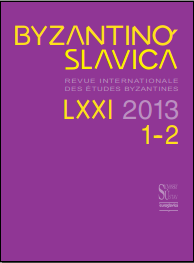Tекстология древнейших свидетельств о росах: Фотий и οί Ρούν Контантинопольского Типикона IX века
Textology of the Oldest Testimonies about Rhos: Photius and οί Ρούν in the Constantinopolitan Typikon of IX c.
Author(s): Olena SyrtsovaSubject(s): Language and Literature Studies
Published by: AV ČR - Akademie věd České republiky - Slovanský ústav and Euroslavica
Summary/Abstract: Notwithstanding the widespread opinion, that the name of Rhos is presented in the Homilies of patriarch Photius, announced on the occasion of the famous attack on Constantinople in 860 and in his Encyclica of 867, the closer examination of the early mss. versions of this epistle according to Baroccianus, gr. 217 (IX c.) and Parisinus, gr. 1228 (XI c.) reveals, that the name of Rhos evidently appeared in the mss. stemma of this epistle not earlier, than in the XIIth century as the historically suggestive, although grammatically doubtful substitution of the authentic adverb τορωσ, attested by Photius Lexicon (Cambridge ms. of X c.). Taking into consideration, that in the text of both Homilies name of Rhos is also absent and is given only in the later lemmas, allows us to overcome still existed hesitation as concerned the historical correlation between the attack on Constantinople in 860 and the Lite in Vlachernai on 25 June on the occasion of the salvation from Sarakivon and Roun, mentioned in the Typicon (Synaxaire) of the Church of St. Sophia (Patm. 266). The Roun of this lite were reasonably identified with those Rhos, who attacked Constantinople. But it could not be the Rhos of Kiev, still dependent from their neighbors at that time and incapable for such ambitious sea expedition. So the question is about two other groups of Rhos, attested for IX c. by the Arabian and Persian authors. The first of these two groups was described in DAI on the Adriatic Seashore under the name of Arentanoi, mentioned by Theophanes Continuatus as Rentanoi, and then by John Diacon, as Narrentanoi. The second group was known in the Latin sources under the name of Rugi, Runi, Rani, Reni, Rutheni. The real ethnic unity of Rentanoi of Adriatic, Runi (Rhos) of Baltic and Rus` (Ruthenoi) of Kiev resulted in the later tendency to attribute the famous attack to Rhos of Kiev.
Journal: Byzantinoslavica - Revue internationale des Etudes Byzantines
- Issue Year: LXXI/2013
- Issue No: 1-2
- Page Range: 59-90
- Page Count: 32
- Language: Ukrainian
- Content File-PDF

